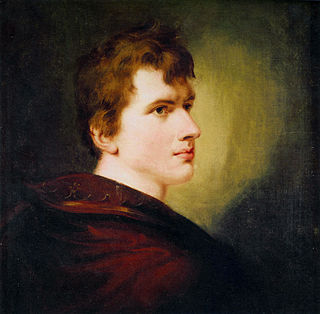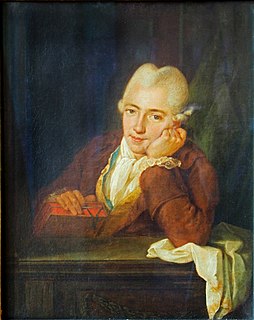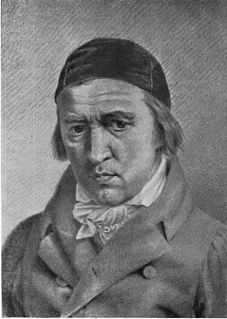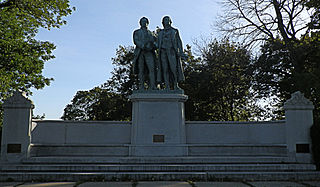Related Research Articles

German literature comprises those literary texts written in the German language. This includes literature written in Germany, Austria, the German parts of Switzerland and Belgium, Liechtenstein, Luxembourg, South Tyrol in Italy and to a lesser extent works of the German diaspora. German literature of the modern period is mostly in Standard German, but there are some currents of literature influenced to a greater or lesser degree by dialects.

The Sorrows of Young Werther is a 1774 epistolary novel by Johann Wolfgang Goethe, which appeared as a revised edition in 1787. It was one of the main novels in the Sturm und Drang period in German literature, and influenced the later Romantic movement. Goethe, aged 24 at the time, finished Werther in five and a half weeks of intensive writing in January to March 1774. It instantly placed him among the foremost international literary celebrities and was among the best known of his works.
This article contains information about the literary events and publications of 1773.
This article contains information about the literary events and publications of 1779.
This article contains information about the literary events and publications of 1786.
This article contains information about the literary events and publications of 1787.

Carl Joachim Friedrich Ludwig von Arnim, better known as Achim von Arnim, was a German poet, novelist, and together with Clemens Brentano and Joseph von Eichendorff, a leading figure of German Romanticism.

Weimar Classicism was a German literary and cultural movement, whose practitioners established a new humanism from the synthesis of ideas from Romanticism, Classicism, and the Age of Enlightenment. It was presumably named after the city of Weimar, Germany, because the leading authors of Weimar Classicism lived there.

Johanna Christiana Sophie Vulpius von Goethe was the longtime lover and later wife of Johann Wolfgang von Goethe.
The "Marienbad Elegy" is a poem by Johann Wolfgang von Goethe. It is named after the spa town of Marienbad where Goethe, 73 years old, spent the summer of 1821. There he fell in love with the 17-year-old Ulrike von Levetzow. Goethe returned to Marienbad in the summer of 1823 to celebrate his birthday. On that occasion, he asked Ulrike, via his friend, Karl August, Grand Duke of Saxe-Weimar-Eisenach, to marry him. She declined.

Johann Wolfgang von Goethe was a German poet, playwright, novelist, scientist, statesman, theatre director, and critic. His works include plays, poetry, literature, and aesthetic criticism as well as treatises on botany, anatomy, and colour. He is widely regarded as the greatest and most influential writer in the German language, his work having a profound and wide-ranging influence on Western literary, political and philosophical thought from the late 18th century to the present day.

Georg Melchior Kraus was a German painter. He was a co-founder of the Weimar Princely Free Drawing School, together with Friedrich Justin Bertuch, in 1776.

Johann Heinrich Meyer was a Swiss painter, engraver and art critic. He served as the second Director of the Weimar Princely Free Drawing School. A close associate of Johann Wolfgang von Goethe, he was often referred to as "Goethemeyer".

The Goethe–Schiller Monument is a public artwork by German artist Ernst Friedrich August Rietschel located in Washington Park, which is in Milwaukee, Wisconsin, United States. The bronze sculpture from 1908 depicts two men, Johann Wolfgang von Goethe and Friedrich von Schiller, one holding a laurel wreath and the other a scroll. The 12 foot artwork rests upon a 26 foot long granite base. The bronze sculpture is a recasting of the statue incorporated into the 1857 Goethe-Schiller Monument in Weimar, Germany.

Classical Weimar is a UNESCO World Heritage Site consisting of 11 sites located in and around the city of Weimar, Germany. The site was inscribed on 2 December 1998. The properties all bear testimony to the influence of Weimar as a cultural centre of the Enlightenment during the eighteenth and early nineteenth centuries. A number of notable writers and philosophers lived in Weimar between 1772 and 1805, including Johann Wolfgang von Goethe, Johann Gottfried Herder, Friedrich Schiller, and Christoph Martin Wieland. These figures ushered in and participated in the Weimar Classicism movement, and the architecture of the sites across city reflects the rapid cultural development of the Classical Weimar era.

Schloss Weimar is a Schloss (palace) in Weimar, Thuringia, Germany. It is now called Stadtschloss to distinguish it from other palaces in and around Weimar. It was the residence of the dukes of Saxe-Weimar and Eisenach, and has also been called Residenzschloss. Names in English include Palace at Weimar, Grand Ducal Palace, City Palace and City Castle. The building is located at the north end of the town's park along the Ilm river, Park an der Ilm. It forms part of the World Heritage Site "Classical Weimar", along with other sites associated with Weimar's importance as a cultural hub during the late 18th and 19th centuries.

The Park an der Ilm is a large Landschaftspark in Weimar, Thuringia. It was created in the 18th century, influenced by Johann Wolfgang von Goethe, and has not been changed much, preserving a park of the period. It forms part of the World Heritage Site "Classical Weimar along with other sites across Weimar bearing testimony to the city's historical importance as a cultural hub during the Weimar Classicism movement in the late 18th and 19th centuries".

Walther Wolfgang Freiherr von Goethe was a German composer and court chamberlain. He was one of the grandsons and last living descendant of Johann Wolfgang von Goethe.

"Harzreise im Winter" is a poem by Johann Wolfgang von Goethe, inspired by his ascent of the Brocken in the Harz mountains during the winter of 1777. He reached the summit in the heat of midday, in deep snow, with the landscape below him shrouded in cloud. The Brocken had always been a place of mystery, connected with witches and devils; where illusions such as the Brocken spectre might confuse an unwary traveller, and where few ventured by choice. This was the inspiration and the setting for his poem.

Baroness Ottilie Wilhelmine Ernestine Henriette von Goethe was a German socialite and the daughter-in-law of Johann Wolfgang von Goethe.
References
- ↑ 2 Brown's Parl. Cases 129, 1 Eng. Rep. 837; 4 Burr. 2408, 98 Eng. Rep. 257; 17 Cobbett's Parl. Hist. 953 (1813).
- ↑ te Winkel, Jan (1924). De ontwikkelingsgang der Nederlandsche letterkunde V, Geschiedenis der Nederlandsche letterkunde van de Republiek der Vereenigde Nederlanden (in Dutch). Vol. 3 (2 ed.). Haarlem: Héritiers F. Bohn. p. 401.
- ↑ "Das Stadtschloss Weimar/The Palace at Weimar" (PDF). Klassik Stiftung Weimar. 2010. Retrieved 2014-06-09.
- ↑ Martin Geck (2003). Bach. Haus Publishing. p. 25. ISBN 978-1-904341-16-1.
- ↑ Miriam Drake (20 May 2003). Encyclopedia of Library and Information Science, Second Edition -. CRC Press. p. 2073. ISBN 978-0-8247-2079-7.
- ↑ Milić Brett, Branislava (2014). Imagining the Morlacchi in Fortis and Goldoni (PhD). University of Alberta. pp. 1–213. doi:10.7939/R3MM45.
- ↑ Cándido María Trigueros (1774). El poeta filosofo; o poesias filosoficas en verso pentametro. En la Imprenta de Don Manuel Nicolàs Vazquez, y Compañia.
- ↑ BBC Two: Writing Scotland.